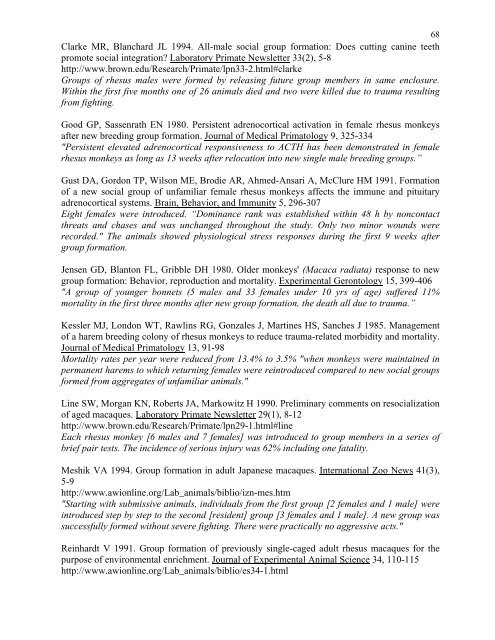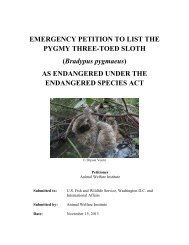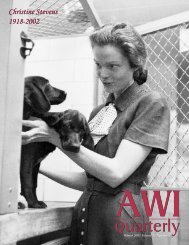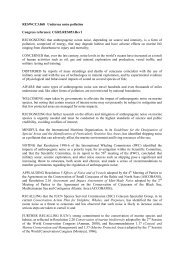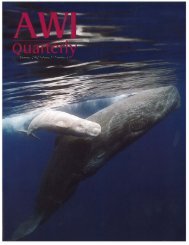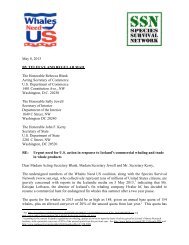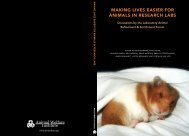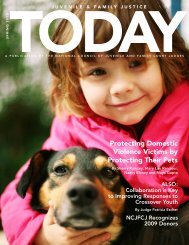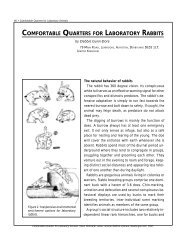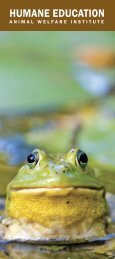Re finem for Annot ment a Prima tated nd En ates K Biblio vironm ...
Re finem for Annot ment a Prima tated nd En ates K Biblio vironm ...
Re finem for Annot ment a Prima tated nd En ates K Biblio vironm ...
You also want an ePaper? Increase the reach of your titles
YUMPU automatically turns print PDFs into web optimized ePapers that Google loves.
68Clarke MR, Blanchard JL 1994. All-male social group <strong>for</strong>mation: Does cutting canine teethpromote social integration? Laboratory <strong>Prima</strong>te Newsletter 33(2), 5-8http://www.brown.edu/<strong>Re</strong>search/<strong>Prima</strong>te/lpn33-2.html#clarkeGroups of rhesus males were <strong>for</strong>med by releasing future group members in same enclosure.Within the first five months one of 26 animals died a<strong>nd</strong> two were killed due to trauma resultingfrom fighting.Good GP, Sassenrath EN 1980. Persistent adrenocortical activation in female rhesus monkeysafter new breeding group <strong>for</strong>mation. Journal of Medical <strong>Prima</strong>tology 9, 325-334"Persistent elevated adrenocortical responsiveness to ACTH has been demonstrated in femalerhesus monkeys as long as 13 weeks after relocation into new single male breeding groups.”Gust DA, Gordon TP, Wilson ME, Brodie AR, Ahmed-Ansari A, McClure HM 1991. Formationof a new social group of unfamiliar female rhesus monkeys affects the immune a<strong>nd</strong> pituitaryadrenocortical systems. Brain, Behavior, a<strong>nd</strong> Immunity 5, 296-307Eight females were introduced. “Dominance rank was established within 48 h by noncontactthreats a<strong>nd</strong> chases a<strong>nd</strong> was unchanged throughout the study. Only two minor wou<strong>nd</strong>s wererecorded." The animals showed physiological stress responses during the first 9 weeks aftergroup <strong>for</strong>mation.Jensen GD, Blanton FL, Gribble DH 1980. Older monkeys' (Macaca radiata) response to newgroup <strong>for</strong>mation: Behavior, reproduction a<strong>nd</strong> mortality. Experi<strong>ment</strong>al Gerontology 15, 399-406"A group of younger bonnets (5 males a<strong>nd</strong> 33 females u<strong>nd</strong>er 10 yrs of age) suffered 11%mortality in the first three months after new group <strong>for</strong>mation, the death all due to trauma.”Kessler MJ, Lo<strong>nd</strong>on WT, Rawlins RG, Gonzales J, Martines HS, Sanches J 1985. Manage<strong>ment</strong>of a harem breeding colony of rhesus monkeys to reduce trauma-related morbidity a<strong>nd</strong> mortality.Journal of Medical <strong>Prima</strong>tology 13, 91-98Mortality r<strong>ates</strong> per year were reduced from 13.4% to 3.5% "when monkeys were maintained inpermanent harems to which returning females were reintroduced compared to new social groups<strong>for</strong>med from aggreg<strong>ates</strong> of unfamiliar animals."Line SW, Morgan KN, Roberts JA, Markowitz H 1990. Preliminary com<strong>ment</strong>s on resocializationof aged macaques. Laboratory <strong>Prima</strong>te Newsletter 29(1), 8-12http://www.brown.edu/<strong>Re</strong>search/<strong>Prima</strong>te/lpn29-1.html#lineEach rhesus monkey [6 males a<strong>nd</strong> 7 females] was introduced to group members in a series ofbrief pair tests. The incidence of serious injury was 62% including one fatality.Meshik VA 1994. Group <strong>for</strong>mation in adult Japanese macaques. International Zoo News 41(3),5-9http://www.awionline.org/Lab_animals/biblio/izn-mes.htm"Starting with submissive animals, i<strong>nd</strong>ividuals from the first group [2 females a<strong>nd</strong> 1 male] wereintroduced step by step to the seco<strong>nd</strong> [resident] group [3 females a<strong>nd</strong> 1 male]. A new group wassuccessfully <strong>for</strong>med without severe fighting. There were practically no aggressive acts."<strong>Re</strong>inhardt V 1991. Group <strong>for</strong>mation of previously single-caged adult rhesus macaques <strong>for</strong> thepurpose of environ<strong>ment</strong>al enrich<strong>ment</strong>. Journal of Experi<strong>ment</strong>al Animal Science 34, 110-115http://www.awionline.org/Lab_animals/biblio/es34-1.html


